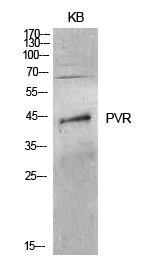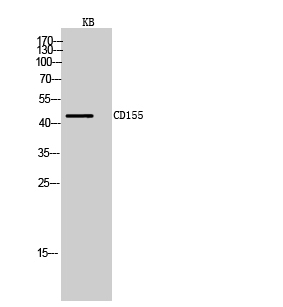

| WB | 咨询技术 | Human,Mouse,Rat |
| IF | 咨询技术 | Human,Mouse,Rat |
| IHC | 咨询技术 | Human,Mouse,Rat |
| ICC | 技术咨询 | Human,Mouse,Rat |
| FCM | 咨询技术 | Human,Mouse,Rat |
| Elisa | 1/10000 | Human,Mouse,Rat |
| Aliases | PVR; PVS; Poliovirus receptor; Nectin-like protein 5; NECL-5; CD155 |
| Entrez GeneID | 5817 |
| WB Predicted band size | Calculated MW: 45 kDa; Observed MW: 45 kDa |
| Host/Isotype | Rabbit IgG |
| Antibody Type | Primary antibody |
| Storage | Store at 4°C short term. Aliquot and store at -20°C long term. Avoid freeze/thaw cycles. |
| Species Reactivity | Human,Mouse,Rat |
| Immunogen | The antiserum was produced against synthesized peptide derived from the Internal region of human PVR. AA range:81-130 |
| Formulation | Purified antibody in PBS with 0.05% sodium azide,0.5%BSA and 50% glycerol. |
+ +
以下是3篇关于CD155抗体的代表性文献摘要:
---
1. **文献名称**:*CD155/TIGIT axis in cancer immunotherapy: current progress and future perspectives*
**作者**:Chauvin JM, Zarour HM
**摘要**:探讨CD155与其受体TIGIT在肿瘤免疫逃逸中的作用,提出阻断CD155/TIGIT通路可增强T细胞抗肿瘤活性,并总结相关抗体药物(如抗TIGIT单抗)的临床前及临床试验进展。
---
2. **文献名称**:*Targeting CD155 in cancer: a promising therapeutic strategy*
**作者**:Sloan KE, et al.
**摘要**:分析CD155在多种肿瘤中的过表达现象及其与不良预后的关联,验证抗CD155抗体通过阻断CD155与DNAM-1/TIGIT的相互作用,恢复抗肿瘤免疫应答的潜力。
---
3. **文献名称**:*Anti-CD155 antibodies enhance NK cell-mediated cytotoxicity against glioblastoma*
**作者**:Zhang C, et al.
**摘要**:研究抗CD155抗体在胶质母细胞瘤模型中的作用,证明其可通过增强自然杀伤细胞(NK细胞)的细胞毒性,抑制肿瘤生长,并联合PD-1抑制剂展现出协同治疗效果。
---
以上文献均发表于2020年后,聚焦CD155作为免疫治疗靶点的机制与应用,涵盖基础研究及转化医学方向。如需具体期刊信息或补充文献,可进一步说明需求。
CD155. also known as poliovirus receptor (PVR) or necl-5. is a cell surface glycoprotein belonging to the immunoglobulin superfamily. Initially identified as a receptor for poliovirus, it plays roles in cell adhesion, motility, and immune modulation. CD155 is broadly expressed in normal tissues but often overexpressed in cancers, correlating with tumor progression and immune evasion. Its interaction with immune receptors like TIGIT, CD96. and DNAM-1 on T cells and NK cells regulates immune activation or inhibition. In the tumor microenvironment, CD155 binding to TIGIT or CD96 suppresses anti-tumor immunity, while engagement with DNAM-1 promotes cytotoxic activity.
CD155-targeting antibodies have emerged as therapeutic tools to disrupt these interactions. Antagonist antibodies blocking CD155-TIGIT/CD96 axes aim to relieve immunosuppression, enhancing T/NK cell function. Conversely, agonist antibodies may exploit CD155-DNAM-1 signaling to boost immune activation. Additionally, CD155 antibodies are explored as cancer-targeting agents for antibody-dependent cellular cytotoxicity (ADCC) or drug conjugates. Preclinical studies highlight their potential in combination with PD-1/PD-L1 inhibitors to overcome resistance. Challenges include balancing specificity to avoid off-target effects and optimizing antibody formats (e.g., IgG, bispecifics) for desired immune modulation. Ongoing clinical trials evaluate CD155 antibodies in solid tumors, underscoring their relevance in immuno-oncology.
×